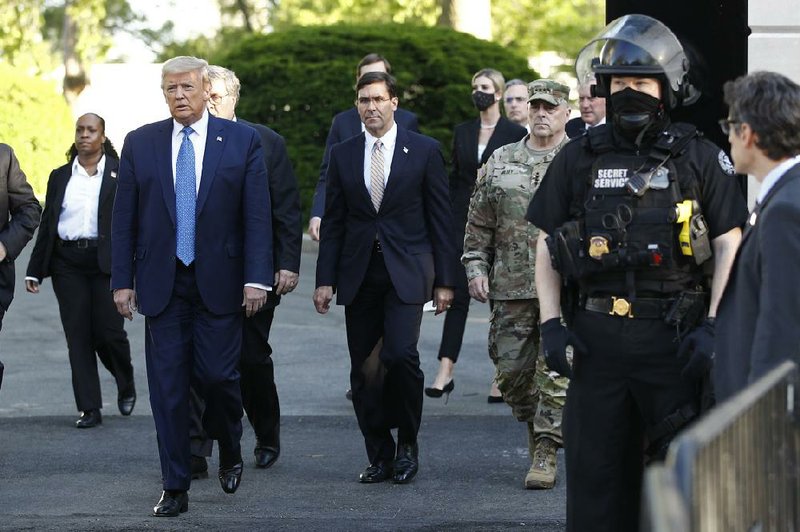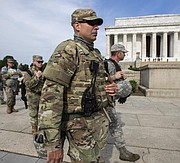WASHINGTON -- In an abrupt reversal, Defense Secretary Mark Esper on Wednesday overturned an earlier Pentagon decision to send a couple of hundred active-duty soldiers home from the Washington, D.C., region, as tensions mounted with the White House over the military response to the protests.
Army Secretary Ryan McCarthy told The Associated Press that he was told about the reversal after Esper attended a meeting at the White House, and after other internal Pentagon discussions.
It was unclear if Esper met with President Donald Trump. McCarthy said he believes the change was based on ensuring that there is enough military support in the region to respond to any protest problems if needed.
McCarthy said he received notice of the Pentagon order to send about 200 soldiers with the 82nd Airborne's immediate response force home just after 10 a.m. Wednesday. Hours later, the Pentagon notified him that Esper had reversed the decision. Esper is the final authority on deployment decisions, but other military officials, including the Joint Chiefs of Staff, also participate in the decision-making.
[Video not showing up above? Click here to watch » https://www.youtube.com/watch?v=m7-1BwEM5No]
Esper said Wednesday that he does not support invoking the Insurrection Act to take greater government control of the response to civil unrest across the United States.
Speaking to reporters at the Pentagon, Esper made his first direct public comments about the killing of George Floyd, a black man whose death in police custody on May 25 has ignited nationwide protests.
"Racism is real in America, and we must all do our very best to recognize it, to confront it and to eradicate it," he said, calling Floyd's death a "horrible crime."
Esper spoke as National Guard forces moved out across the country to assist state leaders in managing the protest upheaval. The president has suggested that he might invoke the Insurrection Act, an 1807 law that would allow him to direct National Guard or active-duty forces over state leaders' wishes, if governors don't act decisively.
"It's a dynamic situation," said McCarthy, adding that the 82nd Airborne troops "will stay over an additional 24 hours, and it is our intent -- we're trying to withdraw them and get them back home."
[Gallery not loading above? Click here for more photos » arkansasonline.com/64guard/]
The active-duty troops have been available but not used in response to the protests.
STILL SECRETARY
Esper's fate was put in public doubt when White House press secretary Kayleigh McEnany declined to offer an endorsement of the Pentagon chief.
Briefing reporters shortly after Esper met with Trump, McEnany declined to describe their conversation.
"And with regard to whether the president has confidence in Secretary Esper, I would say that if he loses confidence in Secretary Esper I'm sure you all will be the first to know," McEnany said.
"So, guys, as of right now, Secretary Esper is still Secretary Esper. And should the president lose faith in him, we will all learn about that in the future."
Esper spoke Wednesday as scrutiny intensifies over several steps in the past week, including remarks in which he characterized American cities or protesters as a "battlespace" that must be dominated and his presence with Trump outside the White House on Monday shortly after authorities employed nonlethal weapons to clear peaceful protesters from the area.
The incidents prompted an unusual spate of public criticism from former Pentagon leaders, including retired Adm. Mike Mullen, a former chairman of the Joint Chiefs of Staff, and retired Army Gen. Tony Thomas, a former commander of U.S. Special Operations Command. They and other retired officers warned against the domestic use of military aggression and politicization of the military.
Former Defense Secretary James Mattis, a retired Marine general, lambasted Trump and Esper in an essay Wednesday in The Atlantic.
"We must reject any thinking of our cities as a 'battlespace' that our uniformed military is called upon to 'dominate,'" Mattis wrote, referring to quotes by Esper and Trump, respectively. "Militarizing our response, as we witnessed in Washington, D.C., sets up a conflict -- a false conflict -- between the military and civilian society."
Sen. Tom Cotton, R-Ark., meanwhile, pressed for the use of the military, writing in an opinion piece that "an overwhelming show of force" was needed to "disperse, detain and ultimately deter lawbreakers."
"Some governors have mobilized the National Guard, yet others refuse, and in some cases the rioters still outnumber the police and Guard combined," Cotton wrote in an opinion article for The New York Times. "In these circumstances, the Insurrection Act authorizes the president to employ the military 'or any other means' in 'cases of insurrection, or obstruction to the laws.'"
A RESIGNATION
On Tuesday evening, James Miller, who served as a top policy official under former President Barack Obama, announced his resignation from the Defense Science Board over what he depicted as Esper's failure to stand up to the president's willingness to use force against protesters.
In an interview with NBC on Tuesday, Esper said he didn't know when he left the White House after a meeting Monday that the president was going to make remarks outside St. John's, a historic church that was set on fire the previous day.
Esper said he thought instead that he was going to inspect a vandalized bathroom and talk to National Guard troops staged in the area.
Esper also defended his use of the term battlespace during a White House call with governors early in the week, an audio except of which was published by The Washington Post.
"I think the sooner that you mass and dominate the battlespace, the quicker this dissipates, and we can get back to the right normal," he told governors. "We need to dominate the battlespace."
Speaking to reporters Wednesday, Esper characterized the term as military jargon for an area in which troops operate and said it was not intended to depict protesting Americans as an adversary or suggest a harsh response.
APOLITICAL ATTEMPT
After Floyd's death in Minneapolis, Esper directed the military's service chiefs not to address the issue until he had, even though some -- with more than 200,000 black service members on active duty -- were interested in doing so.
Asked why that took so long, Esper said it's a "fair question" and referred back to his desire to keep the Defense Department out of politics.
"Remaining apolitical means that there are times to speak up, and times not to," he said.
But Esper said that as it became clear that "this was becoming a very combustible national issue," he determined that he needed to address it. "Given the dynamics, I wanted to lead by crafting my own statement for the department first," he said, referring to a memo that he sent to U.S. troops Tuesday night.
Esper also said he had personally instructed the Army to open an investigation into an incident Monday in which a Lakota medevac helicopter, flown by the District of Columbia National Guard, conducted a low-flying show of force in downtown Washington.
The helicopter, normally designated for use in medical evacuations, hovered low enough to create a deafening noise and spray protesters with rotor wash Monday. The commanding general of the D.C. Guard, Maj. Gen. William Walker, said in a statement Wednesday that he directed the investigation.
Trump on Wednesday first denied and then acknowledged that he had gone to a secure bunker in the White House as protesters demonstrated nearby but said he went there for an "inspection," not because of concerns over his safety.
"Well, it was a false report" that he had gone there for his safety, Trump said during an interview with Brian Kilmeade of Fox News Radio, who had asked if he had been taken to the bunker along with his family as protests continued.
But then Trump reversed himself and said he had gone to the bunker. But he did not say when he went to the bunker or with whom. "I wasn't down -- I went down during the day, and I was there for a tiny little short period of time, and it was much more for an inspection. There was no problem during the day."
Officials said the president was never really in danger, but that he and his family were rattled by the sometimes violent protests near the White House.
Information for this article was contributed by Dan Lamothe, Missy Ryan and Alex Horton of The Washington Post; by Lolita C. Baldor, Zeke Miller, Robert Burns, Michael Balsamo, Sarah Blake Morgan, Ashraf Khalil and James LaPorta of The Associated Press; and by Katie Rogers of The New York Times.
A Section on 06/04/2020

